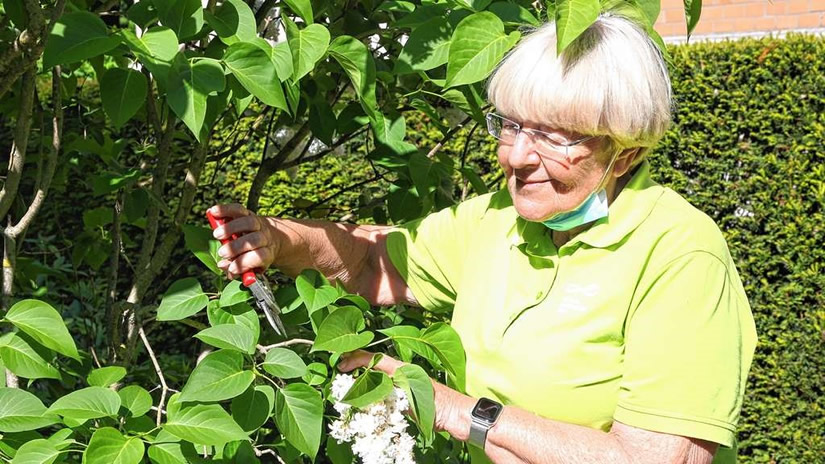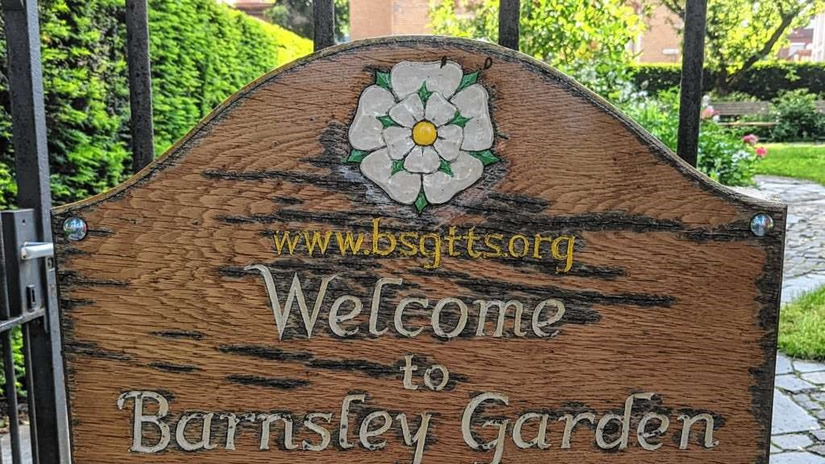News Archive
01/07/21Garden joy for a lifetime - The Barnsley Garden in Schwäbisch Gmünd
 Giving the town twinning a permanent place: This idea was on the program for the 2014 State Horticultural Show. This is how the Barnsley Garden was created on Grabenallee, designed according to English gardening tradition.
Giving the town twinning a permanent place: This idea was on the program for the 2014 State Horticultural Show. This is how the Barnsley Garden was created on Grabenallee, designed according to English gardening tradition.
Not a garden for one season, but for the whole gardening year with blooming surprises that are also colour-coordinated. Even the development in height is no coincidence, low and high-growing plants are arranged accordingly.
Seven years after the garden show, the Barnsley Garden area is one of the most popular places along the city walk.
By Kuno Staudenmaier

Garden joy for a lifetime
The well-tended appearance of Barnsley-Garden in Schwäbisch Gmünd is no coincidence:
Dagi Glasenapp tends the flowers and bushes almost every day and intervenes when necessary.
She has been maintaining the Barnsley Garden in Schwäbisch Gmünd since the state horticultural show.
It is a destination for many visitors to the city and a feast for the eyes all year round.
In all of us, some stimulus can evoke a childhood memory. For some of us it is the memory of the flowers that we saw in our grandparents' gardens and are now looking for in vain. This was written by the English gardening icon Vita Sackville -West (1892 to 1962). A sentence that may also apply to Dagi Glasenapp from Schwäbisch Gmünd, who never forgets that she "took her gardening passion from her grandma". Today this passion also benefits the general public.

Entrance to a little paradise.
© mayr
Dagi Glasenapp volunteers to look after the "Barnsley Garden" on Grabenallee in Schwäbisch Gmünd, which was created for the 2014 State Horticultural Show. A little paradise where strollers feel just as comfortable as bees and butterflies. A garden that reveals its beauties all year round.
But first things first: Dagi Glasenapp grows up in Oberndorf as the oldest of three children. The relationship with grandma is close, grandma's passion is seamlessly transferred to the grandchild. The flowers, the colours, the scent of the summer blooms have done it to her. Nothing has changed to this day. Dagi Glasenapp has never been without a garden throughout all her life.
She gets married, moves to Essen with her husband - he is employed by the UN - and experiences "a high garden culture" there. Small gardens around the house are a matter of course there. Flowers are part of it, the many miners in the Ruhr area also grow vegetables. As a garden connoisseur she appreciates the proximity to Holland, also the proximity to the English gardens, experiments with seeds and saplings, and devours books that expand her gardening knowledge.
Change of location:
Due to her husband's job, they re-locate to Bangkok "I had a garden there too," says Dagi, who now comes into contact with other vegetation and other plants. But she keeps having the same experiences "You always experience the plant three times." You have a pictures in mind, imagining how it looks, taking a seedling in your hand, nurturing it and see it later in all its glory.
Many years later, back in Germany, Dagi Glasenapp decided to move to Schwäbisch Gmünd. Her son has settled there. And because her new home does not have a garden, she adopts one.
"The Barnsley Garden" caught my eye straight away at the garden show, "she recalls. It is one of those gardens that enriched the villas on Parlerstrasse at the beginning of the 20th century. The city was able to lease one of the private properties for the garden show. The idea was to give it up again afterwards. Then the garden lover Dagi comes and offers her services. She does it with such great commitment and success that property owners and the city alike are happy about the garden paradise. The garden is a constant attraction, many visitors come and take a seat on the garden benches or in the pavilion. Dagi Glasenapp also gets into conversation with some of them, often receiving recognition for her work and commitment.

Designed in the style of the English garden tradition, the Barnsley Garden should have been laid out by experts from the English twin town of Schwäbisch Gmünd. Because this was not possible at the time, horticulturists Lutz and Jakob Hokema took over. What became of it is what Dagi Glasenapp enthuses to this day: “There is not a month that I would not be enthusiastic about”
"While a rose garden is full of splendour for perhaps six weeks a year, the English garden has its highlights all year round. That is the real feature and focus of the garden, the coloured accents are everywhere almost continuously over the whole year."

The flowers of summer.
© mayr
At the end of winter, the snowdrops are the first harbingers of early spring, but the Grabenallee area is really famous for its large number of crocuses. They had their origin in the villa gardens.
Dagi is eagerly awaiting the highlights, the flowering of the lilacs enchants the garden in May, then the secondary violets which correspond in colour with the lilac open up and of course the peonies, which are a little later this year and will really delight even after Whitsun. Not to be overlooked are the splendid spherical Allium flowers, a member of the leek family. The rambler rose adds a splash of colour to the pavilion. It's still early summer, but with the poppy seeds and especially the phlox, midsummer is already arriving, they are the plants of July and August.
Vita Sackville-West gives in to melancholy: "I always get sad when the first phlox appears. It heralds the end of intoxicating early summer and reminds us to think about autumn," she writes in her book 'From my garden'.
Dagi Glasenapp takes care of them all, dead heading what has faded and waters on dry days. She is there every day if necessary and is happy that life can also be seen above the flowers. Hundred-year-old maples are part of it and a young pear tree in the middle is a reminiscence of the time the villas were built. At that time it was customary to plant a pear tree in a villa garden.
Then it really is autumn. With the asters, again in the beautiful colours red, lavender, blue and white, the garden year ends - just to restart weeks later.
The Christmas rose is already beginning to show.
Courtesy of







